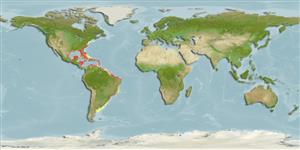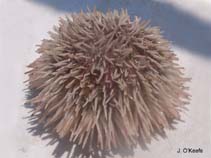Lytechinus variegatus (Lamarck, 1816)
Green sea urchin| Native range | All suitable habitat | Point map | Year 2050 |

|
| This map was computer-generated and has not yet been reviewed. |
| Lytechinus variegatus AquaMaps Data sources: GBIF OBIS |
Classification / Names Common names | Synonyms | CoL | ITIS | WoRMS
| Camarodonta | Toxopneustidae
Environment: milieu / climate zone / depth range / distribution range Ekologi
; payau; kisaran kedalaman 0 - 50 m (Ref. 83942). Tropical; 37°N - 33°S, 99°W - 28°W
Penyebaran Negara-negara | Daerah-daerah FAO | Ecosystems | Kemunculan | Introduksi
Western Central Atlantic: from USA to Brazil, throughout the Caribbean.
Length at first maturity / Size / Weight / umur
Maturity: Lm ? range ? - ? cm Max length : 11.0 cm TL jantan/; (Ref. 415)
This an epibenthic, subtidal species found in seagrass (Ref. 83942), particularly Thalassia beds and lagoonal mangrove cays (Ref. 86574).
Life cycle and mating behavior Kematangan | Reproduksi, perkembang biakan | Pemijahan | telur-telur | Fecundity | Larva
Members of the class Echinoidea are gonochoric. Fertilization is external. Brooding is common, eggs are held either on the peristome, around the periproct or deep into the concavities on the petaloids. Life cycle: Embryos develop into planktotrophic larvae (echinoplateus) and live for several months before they sink to the bottom using their tube feet to adhere on the ground where they metamorphose into young urchins.
rujukan utama
Acuan | Koordinator | mitra
Collin, R., M.C. Díaz, J. Norenburg, R.M. Rocha, J.A. Sánchez, M. Schulze, A. Schwartz and A. Valdés. 2005. (Ref. 415)
Status IUCN Red List (Ref. 130435)
status CITES (Ref. 108899)
Not Evaluated
CMS (Ref. 116361)
Not Evaluated
ancaman kepada manusia
penggunaan manusia
| FishSource |
Alat, peralatan
informasi lanjut
Nama-nama umum
Sinonim (persamaan)
Pemangsa
Reproduksi, perkembang biakan
Kematangan
Pemijahan
Fecundity
telur-telur
pekembangan telor
Sinonim (persamaan)
Pemangsa
Reproduksi, perkembang biakan
Kematangan
Pemijahan
Fecundity
telur-telur
pekembangan telor
Sumber internet
BHL | BOLD Systems | CISTI | DiscoverLife | FAO(Publication : search) | Fishipedia | GenBank (genom, Nukleotida) | GloBI | Gomexsi | Google Books | Google Scholar | Google | PubMed | Tree of Life | Wikipedia (pergi, Cari) | Zoological Record
Estimates based on models
Preferred temperature
(Ref. 115969): 22.8 - 28, mean 26.1 (based on 306 cells).
kategori harga
(Ref. 80766):
Unknown.



